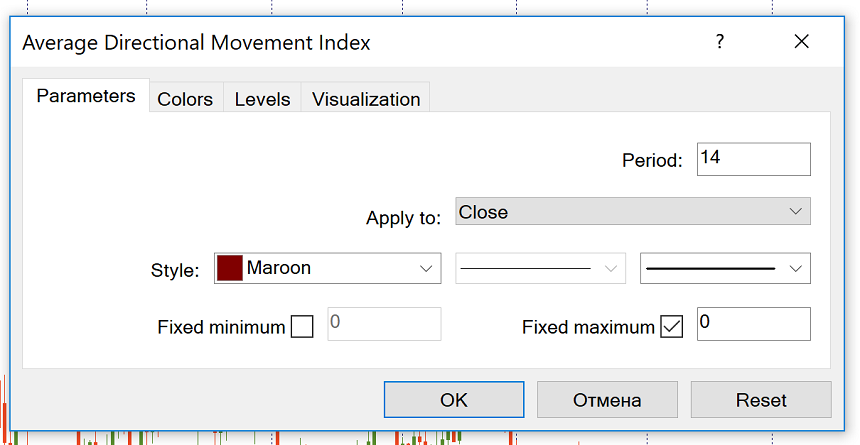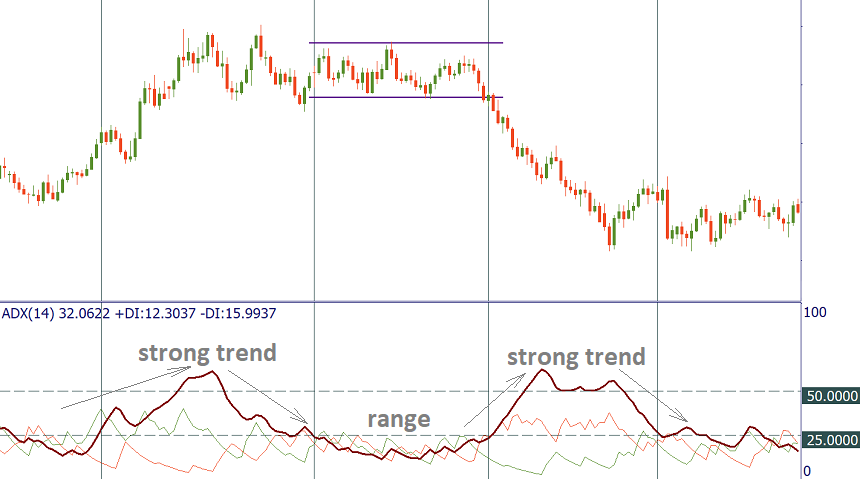The Average Directional Index, or ADX, is the trend strength indicator. Trend traders want to find a strong trend and open positions in its direction. The ADX helps to judge how strong a trend is.
The indicator is based on a moving average of price range expansion over a given period.
ADX Calculation
The Average Directional Index is calculated by measuring the range expansion over a set period. This index considers factors like the Plus Directional Movement (+DM), which shows the difference between two consecutive highs, and the Minus Directional Movement (-DM), indicating the difference between two consecutive lows.
Also, you need a True Range (TR) to make calculations. True Range is the Current High minus the Current Low. Then you need to smooth these values: reduce noise by making the numbers more average-ish. You can make it by turning the numbers in the sequence of averages.
- Calculate the Directional Indicators (+DI and -DI):
- +DI = (Smoothed +DM / Smoothed TR) * 100
- -DI = (Smoothed -DM / Smoothed TR) * 100
- Calculate the Directional Movement Index (DX):
- DX = (abs(+DI - -DI) / (+DI + -DI)) * 100
- Finally, calculate the ADX. The ADX is a moving average of the DX. The period used for the moving average depends on the trader's preference. The standard is 14 periods.
Remember that the ADX itself does not indicate the direction of the trend, only the strength of the trend.
How to implement the Average Directional Index
You can add the ADX to a chart by clicking “Insert” – “Indicators” – “Trend” and then choosing “Average Directional Movement Index.”

By default, the number of periods is set at ‘14’. You can change this number if you want to.
Reading the ADX Indicator
The indicator automatically includes three lines:
- Average Directional Index (ADX) itself (thick brown line). Its values range from 0 to 100. This line registers a trend’s strength but doesn’t show its direction.
- The difference between two consecutive highs is the Plus Directional Movement Indicator (+DMI) (green line).
- Minus Directional Movement Indicator (-DMI) (red line) is the difference between two consecutive lows.
The ADX line is used to determine if an asset is trending or not. A strong trend is in place when ADX is above 25, so there’s a sense to use trend-trading strategies. Consequently, when the ADX is below 25, avoiding trend trading and choosing an appropriate range trading strategy is better. In such moments, the price enters a range.
It’s necessary to point out that the ADX may be used to confirm a range breakout. When the ADX rises from below 25 to above 25, the price is strong enough to continue in the direction of the breakout. However, we would advise you to look for a confirmation. Usually, a retest will do.
ADX value
There are more grades of the ADX value. You can check them in the table below:
ADX Value | Trend Strength |
0-25 | Absent or Weak Trend |
25-50 | Strong Trend |
50-75 | Very Strong Trend |
75-100 | Extremely Strong Trend |
All in all, when the ADX line is going up, the trend strength is increasing, and the price moves in the direction of the trend. When the line goes down, trend strength decreases, and the price goes through a correction or consolidation. Notice that the falling ADX line doesn’t mean that a trend is reversing. It simply means that the current trend is weakening.

In addition, if you look at the series of ADX peaks, you will get information about the trend’s momentum. If there’s a series of higher ADX peaks, trend momentum is increasing. This will let a trader know that he/she may keep the trend trades open letting the profit run. A series of lower ADX peaks means trend momentum is decreasing. Be aware that despite the decreasing momentum, the trend may still continue. Still, a trader must be more attentive and selective about the new entry signals in this case. It might be wise to tighten stops for the existing positions or think about partial take profits.
Trading ADX Signals
+DMI and -DMI define the directional movement. In general, the bulls prevail when +DMI is greater than - DMI, while the bears have the edge when -DMI is greater. Crosses of +DMI and -DMI make a trading system in combination with ADX.
A “Buy” signal occurs when +DMI crosses above -DMI (ADX must be above 25). Stop-loss is usually put at the low of the signal day. The buy signal remains in force as long as this low holds, even if +DMI crosses below - DMI.
And vice versa, a “sell” signal occurs when -DMI crosses above +DMI (ADX must be above 25). The high of the signal day becomes the initial stop-loss.
Combining ADX with Other Indicators
The ADX is a versatile tool. It can be combined with other indicators to enhance trading strategies:
- Using it with moving averages can help verify the trend's strength signaled by the moving average crossover. If the ADX is above 25, it supports the validity of a strong trend, providing further confirmation for the trading signal.
- Another pairing can be with the Relative Strength Index (RSI). RSI indicates overbought or oversold conditions, and when used with ADX, it can provide insight into whether a strong trend might be nearing a reversal, making it a potential exit point for trend traders.
- ADX and Bollinger Bands: Bollinger Bands consist of a middle band, which is a simple moving average, and an upper and lower band, which are standard deviations away from the middle band. It’s like a spread of the price movement. When the price touches the upper band, and the ADX is above 25, it can indicate a strong upward trend. Conversely, if the price touches the lower band with an ADX above 25, it could suggest a solid downward trend.
- ADX and MACD (Moving Average Convergence Divergence): MACD is a trend-following momentum indicator, and it's excellent for identifying short-term price momentum. When the MACD line crosses above the signal line, it generates a bullish signal, while a cross below the signal line suggests a bearish signal. Combining these signals with an ADX reading above 25 can confirm the strength of these trend directions, increasing the reliability of the signals.
Conclusion
The Average Directional Index is a remarkably useful tool for trend traders, and it becomes even more powerful when combined with the analysis of price action and other technical indicators. Whether it's the stock market, forex, or commodities, the ADX can provide valuable insights for any trader.








No comments:
Post a Comment